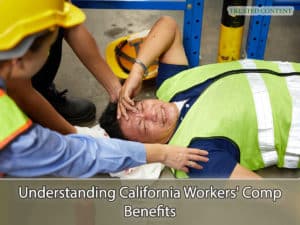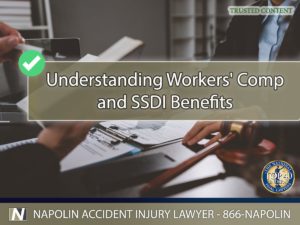Your Guide to Understanding Workers’ Compensation and SSDI Benefits in California
In the wake of an injury or illness that prevents you from working, navigating the complexities of legal and financial support systems becomes a critical step towards recovery and stability. California offers robust protections and benefits for workers facing such challenges, primarily through workers' compensation and Social Security Disability Insurance (SSDI) programs. This guide aims to demystify these benefits, providing you with the knowledge needed to pursue the support you deserve.

Understanding California Workers' Comp Benefits
Understanding California Workers' Comp Benefits
What is Workers' Compensation?
Workers' compensation is a state-mandated insurance program that provides compensation to employees who suffer job-related injuries or illnesses. In California, this program ensures that workers receive medical treatment, wage replacement, and rehabilitation services without the need for litigation. It's a no-fault system, meaning benefits are provided regardless of who was at fault for the injury.
Eligibility and Benefits
To qualify for workers' compensation in California, you must be an employee who suffered a job-related injury or illness. Benefits include medical care, temporary disability benefits, permanent disability benefits, supplemental job displacement benefits, and death benefits. The aim is to cover all necessary medical care and compensate for lost wages due to work-related injuries or illnesses.
Filing a Claim
The process begins with notifying your employer of the injury or illness, followed by filing a claim form (DWC 1). It's crucial to act promptly, as delays can affect the outcome of your claim. Once submitted, your employer will forward the claim to their insurance company, initiating the benefits process.

The Role of Social Security Disability Insurance Benefits
The Role of Social Security Disability Insurance Benefits
Overview of SSDI
Social Security Disability Insurance (SSDI) is a federally run benefits program that provides aid to people who are unable to achieve gainful employment due to a permanent disabling condition. Unlike workers' compensation, SSDI is not limited to injuries or illnesses sustained on the job. Eligibility for SSDI is based on your work history and the severity of your disability.
Differences from Workers' Compensation
The key distinction between SSDI and workers' compensation is the scope of coverage. SSDI benefits are available for disabilities that are not work-related, and the program is funded through payroll taxes. Importantly, receiving SSDI benefits does not preclude you from also receiving workers' compensation; however, the total amount received from both sources may be adjusted.
Applying for SSDI
The application process for SSDI can be lengthy and requires substantial documentation, including medical records and employment history. Approval hinges on proving that your disability is severe enough to prevent you from working in any capacity, not just your previous job. Patience and thorough preparation are key to a successful application.
Can You Receive Both Workers' Compensation and SSDI Benefits?
Combining Benefits
Yes, it is possible to receive both workers' compensation and SSDI benefits simultaneously in California. However, the total amount you receive from both sources may not exceed 80% of your average earnings before your disability. If the combined benefits exceed this threshold, your SSDI benefits may be reduced.
Strategic Considerations
Navigating the interplay between workers' compensation and SSDI benefits requires strategic planning. It's advisable to consult with a legal professional who can help you understand how to maximize your benefits while complying with the legal requirements of both programs.
Additional State Disability Benefits in California
State Disability Insurance (SDI)
California's State Disability Insurance (SDI) program provides short-term benefits to workers who are unable to perform their regular or customary work due to a non-work-related illness, injury, or pregnancy. SDI benefits are funded through employee payroll deductions and are designed to partially replace wages for up to 52 weeks.
Distinguishing SDI from Other Benefits
SDI serves as a complement to workers' compensation and SSDI, targeting different needs and circumstances. Unlike workers' compensation, SDI applies to disabilities not related to work. And, while SSDI provides long-term support, SDI is intended for short-term disabilities, offering a bridge until you can return to work or transition to another form of support.
Navigating the Claims Process: Tips from Experienced Injury Lawyers
Overcoming Common Challenges
The claims processes for workers' compensation and SSDI are fraught with potential pitfalls, from documentation errors to missed deadlines. An experienced injury lawyer can provide invaluable guidance, ensuring that your applications are complete, accurate, and timely. Legal representation can also be crucial in appealing denied claims, a common hurdle in both systems.
The Value of Professional Assistance
A lawyer specializing in workers' compensation and SSDI can help you navigate the complexities of both systems, advocate on your behalf, and ensure that you receive the maximum benefits to which you are entitled. Their expertise can be particularly beneficial in cases where the nature of the disability, the circumstances of the injury, or the interplay between different benefit systems complicates the claims process.

Your Guide to Understanding Workers' Compensation and SSDI Benefits in California
Your Guide to Understanding Workers' Compensation and SSDI Benefits in California
Understanding your rights and the benefits available to you is the first step toward securing the support you need in the wake of a work-related injury or illness. Whether you're navigating workers' compensation, SSDI, or state disability benefits, informed decisions and strategic planning are key to maximizing your benefits. If you're facing the challenges of a work-related injury or illness, don't navigate this complex landscape alone. Call Napolin Accident Injury Lawyer at (866)-NAPOLIN for a free consultation. With extensive litigation experience in workers' compensation and disability claims, we're here to help you secure the benefits you deserve and support you through every step of the process.
- Understanding Uber Accidents and Insurance Coverage Periods in California - April 8, 2025
- A Guide on Red Light Auto Accidents in California - August 14, 2024
- Self-Representing in a California Personal Injury Claim - August 13, 2024
